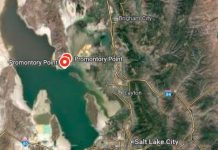BEAVER, Utah, June 17, 2024 (Gephardt Daily) — The Little Twist Fire, which started as a prescribed burn 4 miles southeast of Beaver late last week, has now ballooned to 2,250 acres and is expected to grow even more, thanks to a change in the weather.
According to a Monday update from the Central Utah Fire Interagency Organization, “the fire is expected to be very active with low humidities and strong gusty winds today and tonight.”
What that activity means for an actual increase in size of the wildfire remains to be seen after a relatively calm Sunday, when “the fire saw minimal growth through the afternoon and into the evening with creeping and single tree torching,” the CUFIO press release said.
While temperatures are expected to be cooler over the next few days as “dry cold front” moves into the region, the National Weather Service in Salt Lake City has issued a Red Flag warning for much of southern Utah.
The NWS predicts the “strong cold front will cross the area Monday evening, bringing an abrupt wind shift to the northwest” where wind gusts up to 35 mph are expected to continue, with humidity in most locations predicted to remain below 15 percent.
“Critical fire weather conditions are likely to occur,” the NWS says. “Any new fire starts or existing fires may spread rapidly.”
The Little Twist Fire started as part of the Beaver Ranger District’s long term prescribed burn plan, which successfully burned 4,724 acres over several weeks, according to the Central Utah Interagency Fire Organization. The district plans to burn 3,000-5,000 annually for the next few years.
When the last week’s prescribed burn began to grow “Forest Service leadership made the decision to transition the active portion of the prescribed fire to a wildfire,” the Central Utah Fire Interagency reported.
The transition “allows the Forest Service to make use of additional resources, including those of cooperating agencies, including a Type 3 Incident Management Team to efficiently manage the incident.”
Monday, firefighters were expected to “continue constructing direct and indirect firelines while utilizing natural barriers and favorable fuel types, including previous fuels treatment burn scars, which provide the greatest opportunity to work toward containment of the fire both safely and effectively.
“Some closures will be in place to provide safety for both firefighters and the public,” the CUFIO said.





